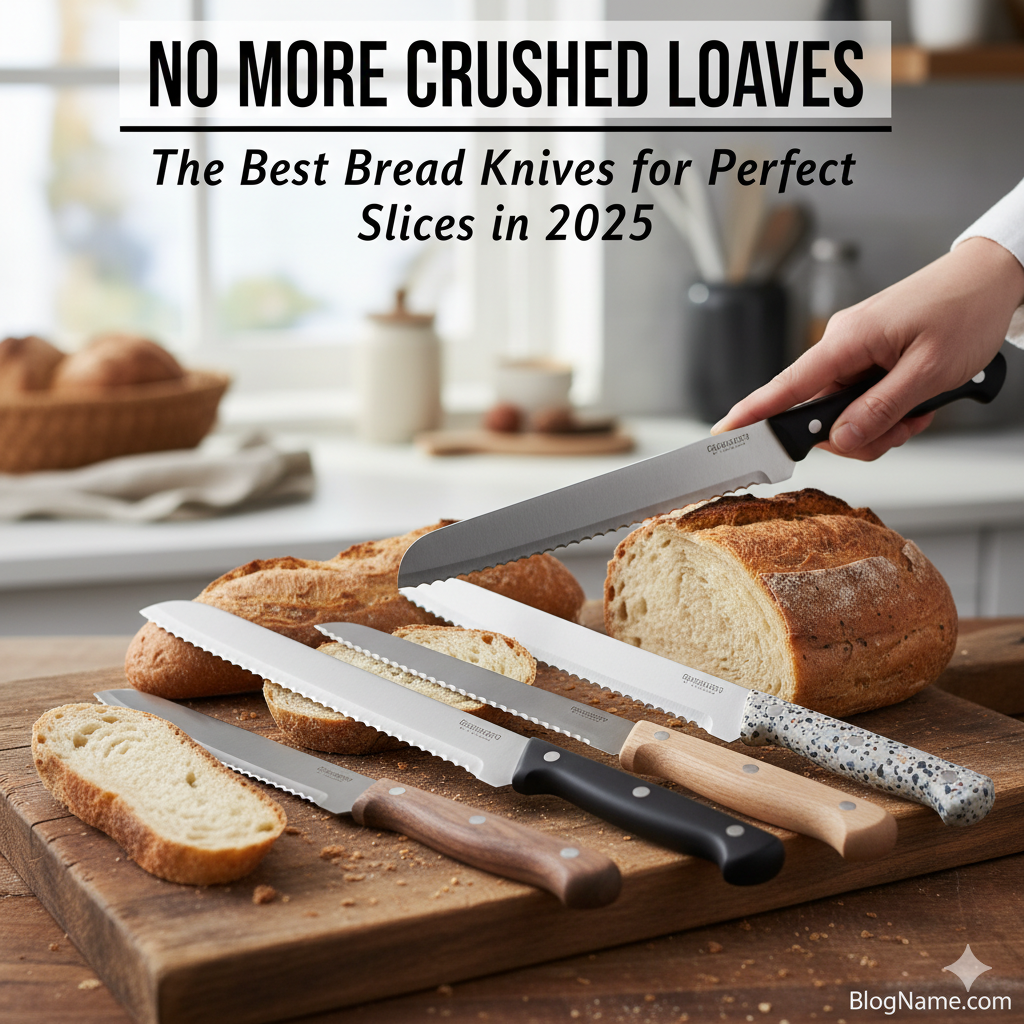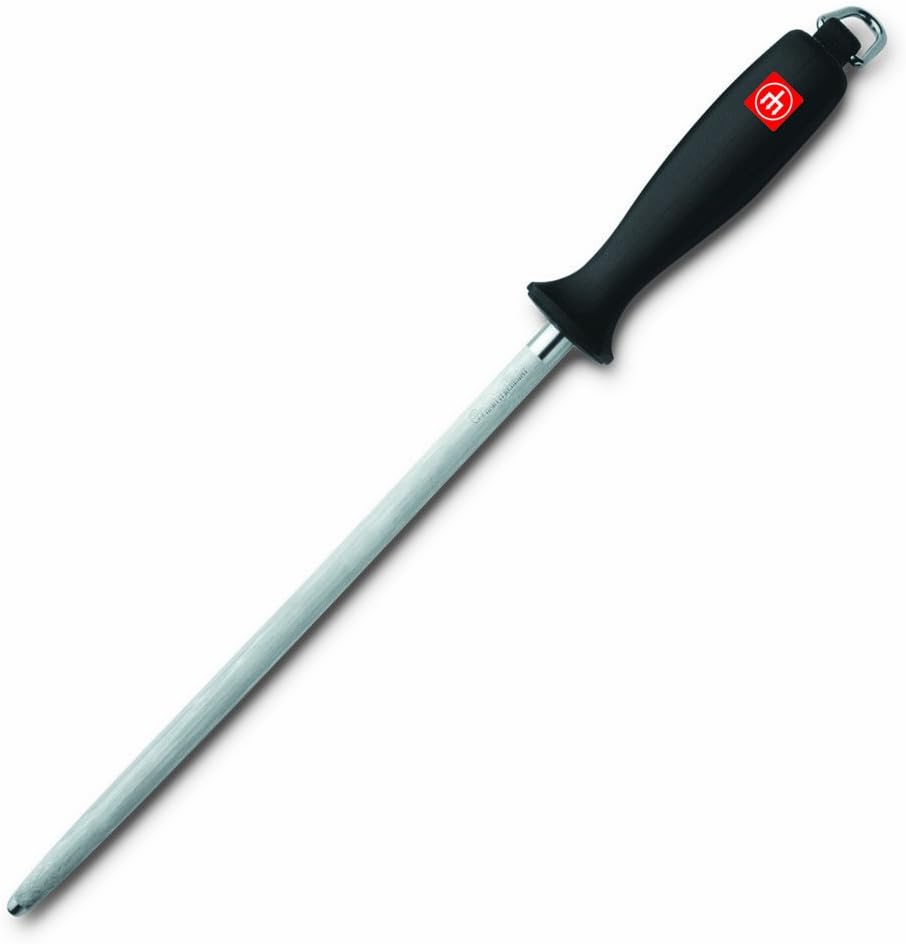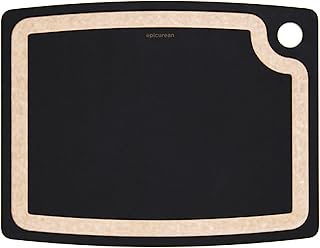No More Crushed Loaves: The Best Bread Knives for Perfect Slices in 2025
There are few things more satisfying than pulling a perfect, golden-brown loaf of sourdough from the oven. And there are few things more tragic than watching that masterpiece get crushed and torn by a dull, inadequate knife. A great bread knife isn’t a luxury; it’s a necessity. It’s the specialist that turns your hard work into beautiful, clean slices.

My Sourdough Saga: A Quest for the Perfect Slice
Like many people, I got deep into sourdough baking a few years ago. I obsessed over starters, hydration levels, and oven spring. I was creating these beautiful loaves with crackly, formidable crusts. But when it came time to slice them, my kitchen turned into a disaster zone. My trusty chef’s knife would skid off the crust before mangling the soft inside. The cheap bread knife I owned wasn’t much better; it would hack and tear, leaving a pile of crumbs and a squashed slice of bread.
It was incredibly frustrating. All that effort, ruined in the final step. My turning point was at a friend’s dinner party. He served a rustic boule and sliced it at the table with a long, elegant Wüsthof bread knife. It went through the crust with a satisfying *crunch* and produced a perfect, clean slice with zero effort. I knew right then that I was using the wrong tool. My journey to find the best bread knife began that night, and this guide is the culmination of everything I’ve learned about what separates a true “crust buster” from a “crumb crusher.”
Beyond the Teeth: What We Look For in a Top-Tier Bread Knife
A bread knife might seem simple, but the details make all the difference. We didn’t just grab the most popular models; we broke down their performance based on the factors that truly matter when you’re facing down a crusty loaf or a delicate tomato.
Our Testing Philosophy: A great bread knife should feel like a saw for bread. It must bite into the crust instantly without pressure, glide through the interior without tearing, and give the user complete control over the thickness of the slice.
- Serration Type & Sharpness: This is the most critical feature. We analyzed the shape of the serrations. Are they sharp and pointed, designed to pierce the crust? Or are they wide and scalloped, which can sometimes glide over it? We looked for aggressive, sharp points that grip instantly.
- Blade Length & Thickness: A longer blade (10 inches is ideal) allows you to slice through wide loaves in a single, smooth stroke. A thin, rigid blade is also key. A thick blade creates more friction and crumbs, while a flimsy one will bow and produce uneven slices.
- Handle Design (Offset vs. Straight): We strongly prefer an “offset” handle, which is raised above the blade. This simple design choice gives your knuckles plenty of room, so you don’t bang them on the cutting board when you finish a slice. It’s a game-changing ergonomic feature.
- Balance and Feel: How does the knife feel in hand? Is it well-balanced, or does it feel clunky and blade-heavy? A comfortable handle and good balance reduce fatigue and improve control. We considered brands that are renowned for their ergonomics, which is a common theme when you compare the best chef knife brands in the world.
- Overall Value: Just like with our search for the best budget chef knife, we’re looking for performance that exceeds the price tag. The knives on this list offer exceptional slicing power for a reasonable investment.
Quick Slices: Our Top Bread Knife Picks for 2025
In a hurry? Here are our top three recommendations that will handle any loaf you throw at them.
| Knife | Image | Best For | Price | Check on Amazon |
|---|---|---|---|---|
| Wüsthof Classic 10-Inch |  |
Overall Performance | ~ $189 | View Price |
| Mercer Culinary Millennia 10-Inch |  |
Best Value | ~ $22.11 | View Price |
| Tojiro Bread Slicer 235mm |  |
Precision & Sharpness | ~ $58 | View Price |
In-Depth Reviews: The Best Serrated Knives Analyzed
Let’s get into the nitty-gritty. We put these knives to the test on everything from crusty sourdough and French baguettes to soft brioche and ripe tomatoes.
1. Wüsthof Classic 10-Inch Bread Knife (Best Overall)
If you want a bread knife that will last a lifetime and perform flawlessly every single time, this is it. The Wüsthof Classic is a masterpiece of German engineering. Its forged, full-tang construction gives it a feeling of incredible sturdiness and perfect balance. The magic, however, is in the “double serrations” or “scalloped and serrated” edge. It has scallops within the serrations, allowing it to bite into the hardest crusts with zero hesitation and then slice cleanly through the soft interior with minimal tearing or crumbs.
The 10-inch length is perfect for even the largest boules, and the classic triple-rivet handle is comfortable and secure. This is a premium tool, and its price reflects that, but its performance is simply in a class of its own. It embodies the quality that makes the Wüsthof vs. Zwilling vs. Shun debate so interesting; it’s a true workhorse.
Who is this knife best for?
The serious home baker or anyone who believes in buying the best tool once and having it for life. Its performance justifies the investment.
- Exceptional “double serration” design
- Forged, full-tang for incredible durability and balance
- Long 10-inch blade handles any loaf size
- Effortlessly slices through hard crusts
- Made in Solingen, Germany
Pros
- Premium price point
- Heavier than stamped alternatives
Cons
2. Mercer Culinary Millennia 10-Inch Wavy Edge (Best Value)
Just as its chef knife counterpart dominates the budget category, the Mercer Millennia bread knife offers unbelievable performance for its price. Often available for under $30, this knife is a favorite in professional kitchens and culinary schools for its no-nonsense functionality. The 10-inch blade is made from high-carbon Japanese steel and features sharp, effective serrations that make quick work of crusty bread.
The handle is its secret weapon: a comfortable, non-slip Santoprene and polypropylene blend that provides a secure grip, much like the acclaimed Victorinox Fibrox series. In fact, seeing how these two value-focused brands compare is a fascinating study, much like our Henckels vs. Victorinox analysis. It’s not a forged, heirloom piece like the Wüsthof, but for pure slicing power on a budget, it is impossible to beat.
Who is this knife best for?
Literally everyone else. If you’re not ready to invest in the Wüsthof, buy this knife. It’s the best value on the market, bar none.
- Incredible performance for the price
- Long 10-inch blade
- High-carbon Japanese steel
- Extremely comfortable and secure non-slip handle
- Lightweight and easy to handle
Pros
- Stamped blade lacks the heft of a forged knife
- Aesthetics are purely functional
Cons
3. Tojiro Bread Slicer F-737 (Sharpness Champion)
This knife is a cult classic among knife enthusiasts, and for good reason. The Tojiro bread slicer is wickedly sharp. Made in Japan, its thin, flexible blade with razor-like serrations glides through bread with an eerie lack of resistance. If you want slices so thin you can read through them, this is your knife. It produces almost zero crumbs and excels at delicate tasks like slicing angel food cake or trimming brisket.
The blade is slightly shorter than others on this list (~9.25 inches), and its flexibility, while great for some tasks, can make it tricky to get a perfectly straight cut on a very wide, crusty loaf. The simple, unfinished wood handle is functional but not as ergonomic as the Mercer or Wüsthof. However, for sheer cutting ability, it’s a marvel and an incredible value.
Who is this knife best for?
The precision-obsessed cook who values sharpness above all else. It’s also an excellent choice for those who need to slice soft, delicate items without any tearing.
- Phenomenally sharp serrations
- Creates very few crumbs
- Flexible blade is great for fine slicing
- Excellent value for a Japanese-made knife
Pros
- Blade flexibility can be a drawback for rustic loaves
- Handle is very basic
- Requires hand washing and drying immediately
Cons
4. Victorinox Fibrox Pro 10.25-Inch Serrated Knife (The Ergonomic Workhorse)
It’s no surprise to see another Victorinox on a “best of” list. Known for creating some of the world’s best-value knives, their bread knife is another stellar example of performance-first design. This knife features a long 10.25-inch blade with wide, scalloped serrations and the legendary Fibrox Pro handle that is beloved by professional chefs for its comfort and non-slip grip.
The scalloped serrations are slightly less aggressive on hard crusts than the Wüsthof’s pointed teeth, but they are exceptionally good at slicing soft breads, cakes, and even roasted meats without tearing. The blade has a slight curve, making it great for long, smooth slicing motions. If you already own and love their chef’s knife, this is a natural and excellent addition to your collection. Our Victorinox chef knife reviews highlight the consistent quality across their entire line.
Who is this knife best for?
Anyone who prioritizes handle comfort and safety, or fans of the Victorinox brand looking for a reliable, long-bladed slicer for a variety of tasks beyond just bread.
- Supremely comfortable and ergonomic Fibrox handle
- Very long 10.25-inch blade
- Lightweight and easy to control
- Versatile for bread, roasts, and large fruits
- Excellent Swiss-made quality
Pros
- Wider, scalloped serrations can be less effective on very hard crusts
- Not an offset handle
Cons
Anatomy of a Great Bread Knife: Offset vs. Straight, Length, and Serrations
Understanding the key features of a bread knife will help you choose the perfect one for your needs. It’s not just about having “teeth.”
The Offset Advantage: Why Knuckle Clearance Matters
An offset handle is one of the single best features to look for. Because the handle is raised, your hand is kept far away from the cutting board. With a straight-handled knife, you often have to tilt the blade up at the end of a slice to avoid rapping your knuckles on the counter, which can lead to an uneven final piece. An offset knife (like the Mercer Millennia) solves this problem completely, allowing for a full, clean slice every time. For this reason alone, we often recommend it over straight-handled competitors.
Serration Science: Pointed vs. Scalloped
Not all serrations are created equal. Pointed serrations, like those on the Wüsthof or Tojiro, act like tiny claws. They are extremely aggressive and excel at piercing tough, crusty exteriors. This is what you want for rustic sourdough or a crusty baguette. Scalloped serrations, like on the Victorinox, have rounded gullets. They are gentler and produce a very smooth cut, making them excellent for softer items like brioche, chiffon cake, or even tomatoes. They are less prone to tearing delicate crumb structures.
Preserving the Bite: How to Care for Your Serrated Knife
A high-quality serrated knife can stay sharp for years—sometimes over a decade—with proper care. The good news is that it’s simpler than caring for a straight-edged knife.
- Hand Wash Only: Just like a chef’s knife, never put a bread knife in the dishwasher. The detergents are abrasive, and the high heat can damage the handle. Wash gently with a sponge (be careful of the serrations!) and dry immediately.
- Store Safely: Don’t let it rattle around in a drawer. Use a knife block, a magnetic strip, or a simple plastic sheath to protect the serrated edge from getting dinged.
- Avoid Hard Surfaces: Only cut on wood or plastic cutting boards. Never cut on ceramic plates, glass, or stone countertops, as this will instantly dull the points of the serrations.
- To Sharpen or Not to Sharpen?: Sharpening a serrated knife is a painstaking process involving a special tapered sharpening rod. For budget knives like the Mercer or Tojiro, it’s often more cost-effective to simply replace the knife after 5-10 years of use. For a premium knife like the Wüsthof, you can send it to a professional sharpening service every decade or so.
Frequently Asked Questions (FAQ)
Do I really need a separate bread knife?
Absolutely, 100%. A serrated bread knife is a specialized tool. Its “teeth” are designed to saw through a hard, brittle crust without requiring downward pressure, which would crush the soft, airy crumb inside. Using your primary chef’s knife on bread will squash the loaf and can severely dull your blade’s fine edge.
What’s the ideal length for a bread knife?
We recommend a blade length of at least 9 inches, with 10 inches being the sweet spot. A longer blade allows you to use a smooth, single sawing motion to get through even wide, round artisan loaves. A shorter knife requires more back-and-forth sawing, which can create more crumbs and a less clean cut.
What is an offset bread knife and why is it better?
An offset bread knife has a handle that is positioned higher than the blade’s edge. This ergonomic design provides crucial knuckle clearance, which prevents your hand from hitting the cutting board as you finish slicing through the bottom of the loaf. It allows for a more comfortable, efficient, and complete cut.
Can I use a bread knife for other things?
Yes! A good serrated knife is surprisingly versatile. It’s the best tool for slicing delicate, soft-skinned fruits and vegetables like tomatoes, peaches, and bell peppers. It’s also excellent for leveling cakes, slicing sandwiches, and carving roasted meats with a tough skin, like a pork roast.
The Final Cut: Your Best Choice for Flawless Slices
A great bread knife is a transformative tool. It brings a sense of ease and satisfaction to your kitchen, ensuring that every loaf you bake or buy is treated with the respect it deserves.
If you’re looking for the absolute best, a “buy it for life” tool that will never let you down, the Wüsthof Classic 10-Inch Bread Knife is the pinnacle of performance. Its engineering and cutting ability are second to none.
However, for the vast majority of people, the Mercer Culinary Millennia 10-Inch offers performance that comes astonishingly close for a tiny fraction of the price. It is, without question, the best value on the market and our strongest recommendation for most home kitchens.
Whichever you choose, investing in a proper bread knife is one of the easiest ways to upgrade your entire kitchen experience. Say goodbye to crushed bread and messy countertops, and hello to perfect, effortless slices, every single time.























